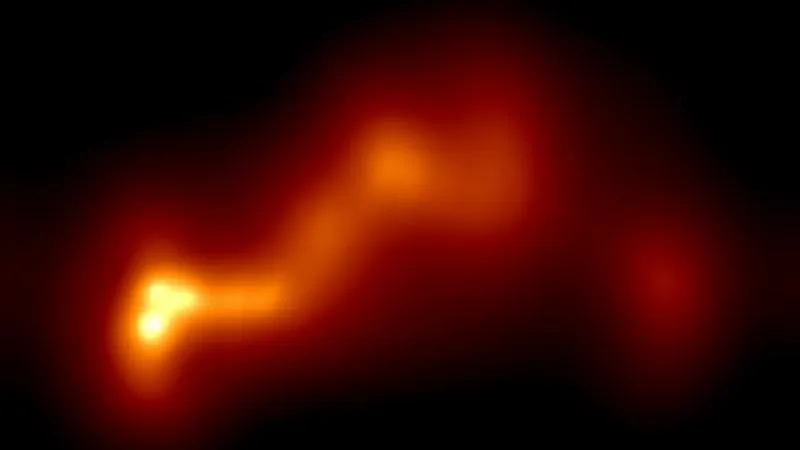
OJ 287: Stunning New Image Reveals Secrets of a Distant Galaxy
2025-08-03
Author: Sarah
Astronomers Unlock the Mysteries of OJ 287
For over 150 years, the enigmatic OJ 287 galaxy, located a staggering five billion light-years away, has captured the imagination of astronomers. Its bright variations hint at an extraordinary phenomenon: the merger of two supermassive black holes at its core.
Groundbreaking Imaging Breaks New Ground
In a groundbreaking achievement, an international research team led by Dr. Efthalia Traianou from Heidelberg University has captured a new image of the galaxy's nucleus, revealing astonishing detail never seen before. Utilizing a sophisticated space radio telescope, the researchers discovered a previously unknown, intricately curved segment of the plasma jet emanating from OJ 287's center, offering unprecedented insights into the extreme conditions surrounding supermassive black holes.
Blazing Bright: Understanding Blazars
The core of OJ 287 is classified as a blazar, known for its intense activity and brilliant luminosity. At their heart, these active galactic nuclei are powered by black holes that consume surrounding matter, launching colossal plasma jets rich in cosmic radiation, heat, and magnetic fields. Dr. Traianou emphasizes the significance of their findings, noting, 'We have never before observed a structure in the OJ 287 galaxy at the level of detail seen in this new image.'
Extreme Energies Unveiled
This groundbreaking image penetrates the galaxy's center, showcasing the sharply curved, ribbon-like structure of the plasma jet. Strikingly, some regions within the jet surpass temperatures of ten trillion degrees Kelvin—an astonishing indication of the immense energy dynamics present near a supermassive black hole. The team also detected a newly formed shock wave, a phenomenon attributed to energies in the trillion-electron volt range, linking it to a peculiar gamma-ray measurement from 2017.
A Cosmos-Spanning Telescope
To achieve this high-resolution image, the researchers utilized a ground-space radio interferometer that combined the capabilities of a ten-meter-long antenna aboard the Spektr-R satellite with a network of 27 ground-based observatories around the globe. This created a virtual telescope five times larger than Earth itself, harnessing the wave nature of light to create an unparalleled view of the galaxy.
Future Research on Merging Black Holes
The resulting interferometric image bolsters the hypothesis that a binary supermassive black hole resides within OJ 287, enhancing our understanding of how the movements of such colossal black holes shape and direct the plasma jets they emit. Dr. Traianou concludes by highlighting the galaxy's unique attributes, stating, 'Its special properties make it an ideal candidate for further research into merging black holes and the associated gravitational waves.'


 Brasil (PT)
Brasil (PT)
 Canada (EN)
Canada (EN)
 Chile (ES)
Chile (ES)
 Česko (CS)
Česko (CS)
 대한민국 (KO)
대한민국 (KO)
 España (ES)
España (ES)
 France (FR)
France (FR)
 Hong Kong (EN)
Hong Kong (EN)
 Italia (IT)
Italia (IT)
 日本 (JA)
日本 (JA)
 Magyarország (HU)
Magyarország (HU)
 Norge (NO)
Norge (NO)
 Polska (PL)
Polska (PL)
 Schweiz (DE)
Schweiz (DE)
 Singapore (EN)
Singapore (EN)
 Sverige (SV)
Sverige (SV)
 Suomi (FI)
Suomi (FI)
 Türkiye (TR)
Türkiye (TR)
 الإمارات العربية المتحدة (AR)
الإمارات العربية المتحدة (AR)